ISSN
2307–3489 (Print), ІSSN 2307–6666 (Online)
Наука
та прогрес транспорту. Вісник
Дніпропетровського
національного університету залізничного
транспорту, 2019, № 2 (80)
ТРАНСПОРТнЕ
БУДІВНИЦТВО
транспортнЕ
БУДІВНИЦТВО
UDC 624.94.014.2:69.059.7
N.
G.
KRUHLIKOVA1*,
D. О.
BANNIKOV2*
1*Fac.
«Industrial and Civil Engineering»,
Dnipro National University of Railway Transport
named after
Academician V. La-zaryan, Lazaryan, St. 2, Dnipro,
Ukraine, 49010,
tel. +38 (063) 94 67
288, e-mail dnuzt@diit.edu.ua,
ORCID 0000-0003-2822-6696
2*Dep.
«Construction Production
and Geodesy»,
Dnipro National University of Railway
Transport named after
Academician V. Lazaryan, Lazaryan, St. 2,
Dnipro, Ukraine,
49010,
tel. +38 (063) 400 43 07, e-mail bdo2020@yahoo.com
ORCID
0000-0002-9019-9679
RATIONAL
DESIGN OF
SHORT-SPAN
INDUSTRIAL
BUILDING ROOF
FOR RECONSTRUCTION CONDITIONS
Purpose.
Recently, the demand for reuse of industrial buildings that have not
been in operation for some time has been increasing in Ukraine.
Herewith, quite often the design of their roof requires the complete
replacement and renovation by using modern roofing materials to meet
the requirements of new government standards. Therefore, the choice
and justification of the rational design of steel roof on the example
of a short-span industrial building (18-24 m span), which is
planned to be returned to exploitation after idle time, is the main
goal of this publication. The object of the analysis is an unheated
building equipped with bridge cranes of a small capacity (up to 10
tons). Methodology.
To achieve this purpose, the comparison of structural variants of a
roof steel collar tie was performed. Such variants include two types
of collar tie cross-section – a
lattice truss and a solid I-girder. The first type was analyzed for
four possible types of section of elements – double angles, a
roll-welded square profile, an electric-welded round tube and a
rolled round tube. The second type was analyzed for two possible
types of section – rolled I-section made of normal strength steel
and fabricated sections of thin-gage high-strength steel. The design
variants were compared on the basis of a numerical analysis of their
work using the finite element method based on the software complex
SCAD for Windows. Findings. According to the research results
it should be stated that for the conditions of the city of Dnipro the
most cost-effective variant of the steel collar tie cross section for
the short-span industrial building is the truss made of
electric-welded round tubes. Also the construction of collar tie made
of roll-welded square profiles or fabricated section of thin-gage
high-strength steel is considered quite effective. Originality.
The research presented in the publication allows
estimating the possibility and economic efficiency of usage for
various types of cross-sections for the collar tie of a steel
non-insulated roof of the industrial building for the reconstruction
conditions in the Dnipro-city. Practical value. A practical
estimation of mass and cost parameters for steel collar ties of
various types has been carried out, and the methodology for
conducting such estimation has been substantiated.
Keywords:
industrial
building;
collar tie; girder;
truss;
software
complex
SCAD
for
Windows;
finite
element
method
Introduction
Currently, in
Ukraine one of the key problems in the field of exploitation of the
industrial enterprise structures is the level of their technical
condition. This is especially true for such buildings, which for
some time were not in operation, but were, so to speak, «on their
own». During such an idle period some structures degraded, maybe
went to ruins, and the other remained in a semi-usable state of
operation. However, attempts to return such structures to operation
are increasingly observed in practice, because it is often a cheaper
option than the construction of a completely new object.
As a rule, such reuse of
building structures is accompanied by their full or partial renewal,
depending on their technical condition, and the building itself is
redesigned to the requirements of new modern design standards and
potentially new equipment to be installed. Most often it is the roof
that requires renovation, because, on the one hand, it is in the
most unfavorable conditions during idle time, and on the other hand,
the roof itself often limits the dimensions for the installation of
new equipment in the building.
It should also be noted that the
demand for short-span buildings, such as storage buildings, has been
particularly active recently. This is due to their relatively low
cost, as well as the desire to use them in the future for production
processes in the small business.
Purpose
Taking into account the
foregoing, the main purpose of the study conducted by the authors is
to choose and justify the rational design of steel roof on the
example of a short-span industrial building (18-24 m span), which is
planned to be returned to exploitation after idle time. The object
of the analysis is an unheated building equipped with bridge cranes
of a small capacity (up to 10 tons).
To achieve this, it was
necessary first to analyze the existing and approved roof design
variants, suitable for use in such buildings, then to compare these
variants, taking into account both their carrying capacity and the
estimated cost, and to choose the best variant that can be proposed
for practical implementation.
Methodology
Given the nature of the
industrial building in question, the design of its roof should
provide for the use of bearing collar ties, which include a system
of purlins and steel profiled flooring. This roof type is proved
itself good in practice and is considered to be the main one for
modern non-heated industrial buildings [10].
It
is also
worth noting
that abroad the
short-span
industrial buildings,
which are
quite popular,
have a
similar roof
design solution
[13].
The main issue, when designing
such short-span roofs, is the choice of type of collar tie. For this
purpose, straight-axis collar ties (trusses or beams) may be used,
as other types of bearing structures, such as arches or frames, are
more suitable for significant spans. The slope of the upper chord of
the collar ties in accordance with the standard requirements [6]
shall be not less than 20% (11°), which is due to the need of
preventing the water flow through the profiled sheet joints to the
building. In case of installation of such roofs on the 10 – 20%
(5.5 – 11°) slopes there are must be provided the sealing of
joints between the flooring sheets. However, as the experience of
operation shows, firstly, such works are technologically costly, and
secondly, over time, sealing requires periodic renewal. Therefore,
the practice of such roofs with small slopes is mostly abandoned.
Taking into account the above
limitations, a triangular truss with a triangular lattice with
additional posts, as the most economical one, was accepted as a
lattice truss during the studies. At the same time, four types of
sections of the elements of such a truss were analyzed, which are
now used in metal structures and available on the Ukrainian steel
market: – angles (according to GOST 8), roll-welded square
profiles (according to GOST [3]), electric-welded round tubes
(according to GOST [1]) and rolled round tubes (according to GOST
[4]). For the first two types of cross-sections, C255 grade
steel was used, which is the minimum allowable for structures of
group 1 according to the standard [7]. For the last two types of
round tube cross-sections, C245 grade steel was used according to
this standard.
As a solid girder, we considered
two types of beams – rolled I-section girder (according to GOST
[2]) and a plate girder made of high-strength steel of C325 grade,
which is becoming more and more popular at the modern market of
Ukraine. To ensure the desired slope, the girder had an asymmetrical
design.
Roof loads were determined
according to the current standards in Ukraine [5]. Since, at a given
angle of inclination of 11° the wind load is upward due to the
negative aerodynamic coefficient, we took into account only the
proper weight of the roof together with the collar tie and snow
load.
To specify the research, we
considered the object – the industrial storage building, located
in the city of Dnipro at the address of Panikakhi street 1, which
for a long time (almost 15 years) was not in operation (Fig. 1).
According to the data of its survey, carried out by a specialized
organization, the roof design should be completely replaced by a
new one, since its technical condition was assessed as the state of
failure.
One
of the
peculiarities of
the building
under
consideration
was a
varying span,
which for
its main
part was
24 m, and
for final
sections
decreased to
18 m. Therefore,
in order
to provide
the required
slope of
the roof,
it was
necessary to
develop a
design of
a universal
collar tie that
would provide
the required
slope of
the roof
without changing
the type
of the
collar tie
itself.
For
conducting variant calculations we used an extremely popular and
approved numerical method of building mechanics – the method of
finite elements [12, 14, 15] based on the well-known domestic
software complex SCAD for Windows [11]. The constructed calculation
models for the considered collar tie design variants are shown in
Fig. 2 – 5. The trusses and the rolled girder were modelled by rod
finite element of universal type, and the plate girder was modeled
by plate four-node finite elements of isoparametric type. All
calculations
were performed
in geometrically
and physically
linear settings.
This approach avoids issues of estimating
the convergence of results peculiar for finite elements of other
types [9].
Findings
According to
the calculation results for truss-type collar ties the sections of
the elements were selected for each of the four constructive types.
Herewith, upon selection the cross sections were adjusted according
to the rules of unification. Also, according to the unification
results, a universal truss for 18 and 24 m spans was formed,
which consisted of the largest profiles. These data are presented in
Table 1.
For the
I-section collar ties the profile 70B1 was selected. For the collar
ties in the form of fabricated sections the 1.3 m high profile was
chosen for the elements thickness of 4 mm and 1.0 m high profile –
for the elements thickness of 6 mm. Herewith the condition of
stiffness was the determining condition.
Based on the
results of calculations, a summary table was drawn up, which takes
into account the total costs for the profiles of the collar ties of
each type. Data are taken as averaged generalizations at the rolled
metal market in the city of Dnipro for November-December 2018.
However, this analysis allows us to reveal a general picture.
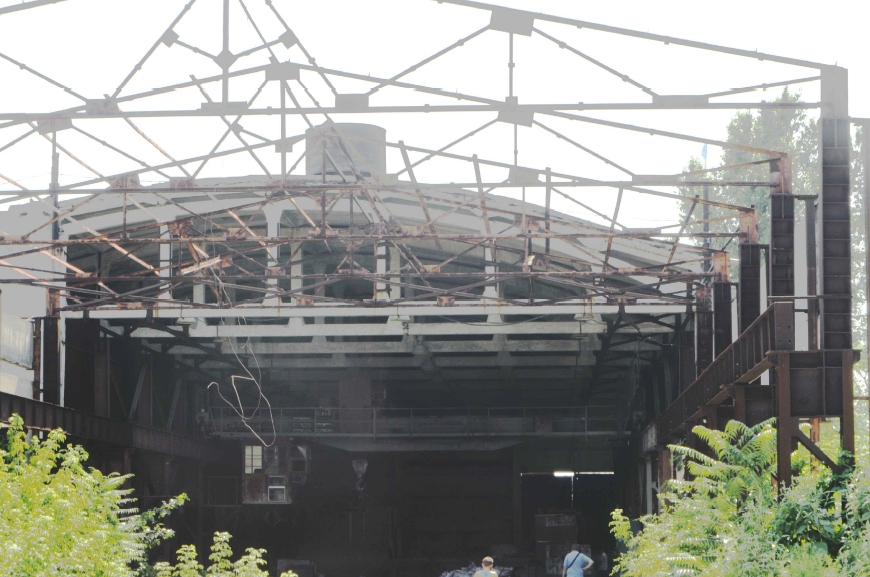
Fig. 1. Object of
the research – short-span industrial storage building
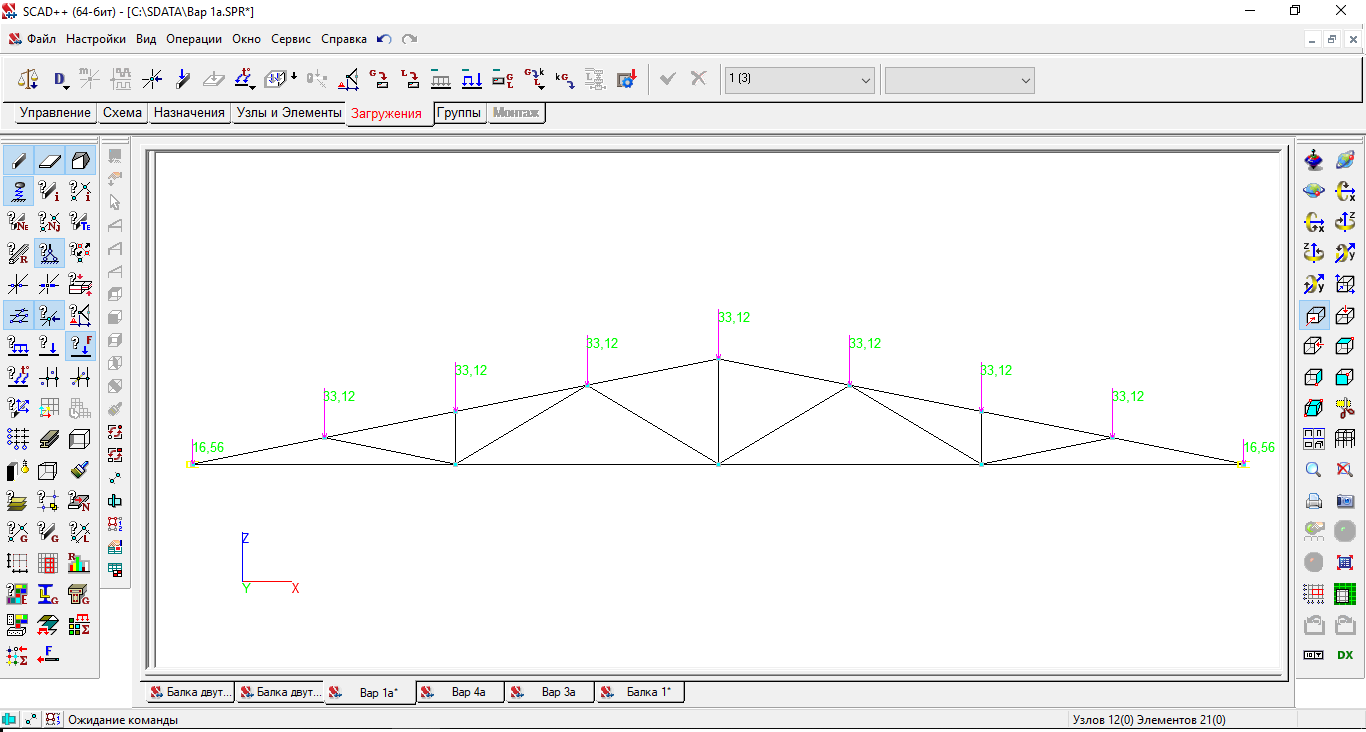
Fig. 2.
Finite-element model of 24m span truss
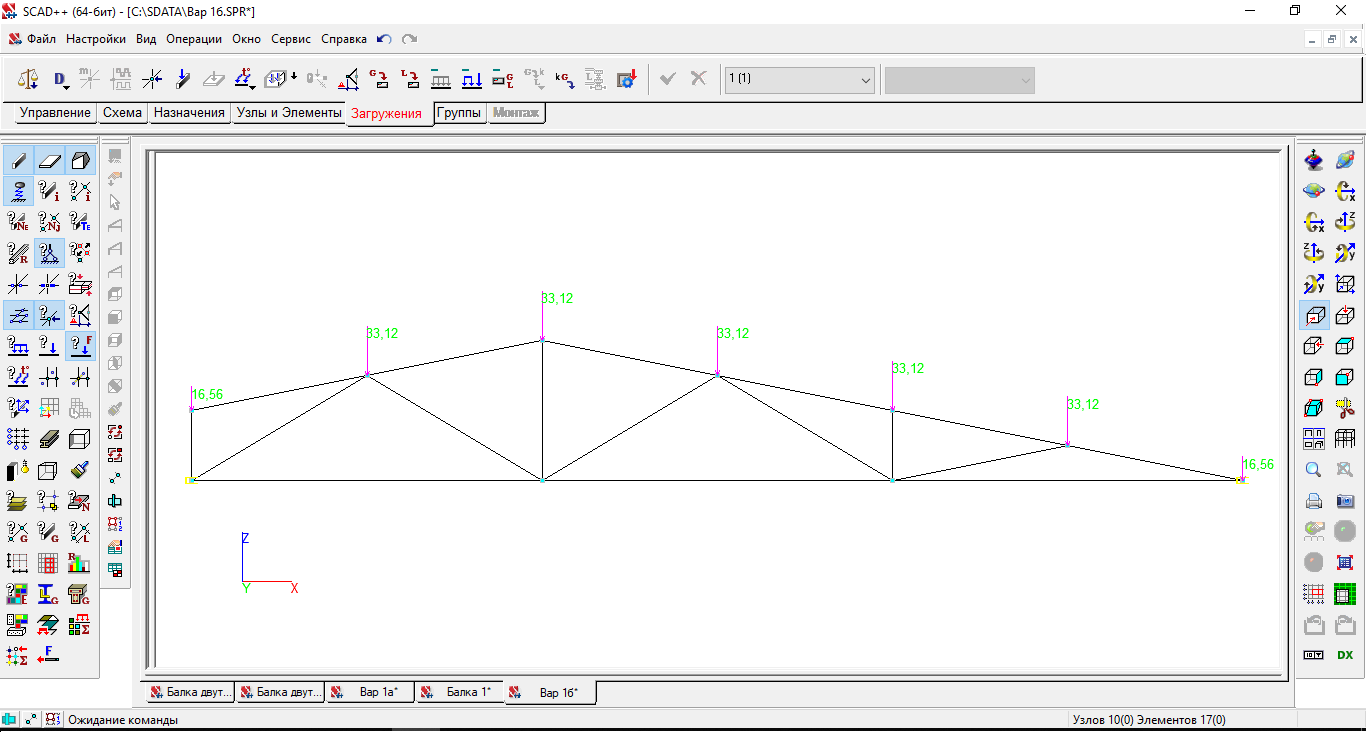
Fig. 3.
Finite-element model of the shortened 18 m span truss
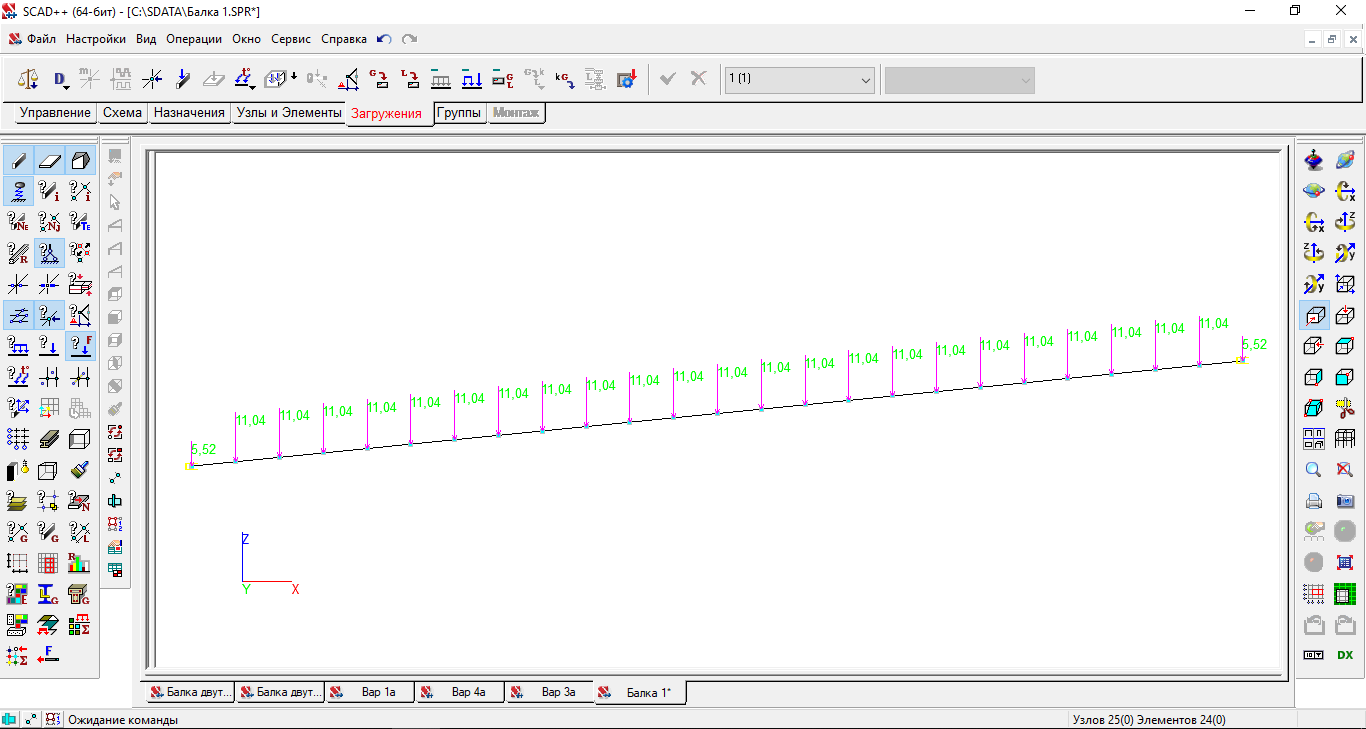
Fig. 4.
Finite-element model of rolled girder
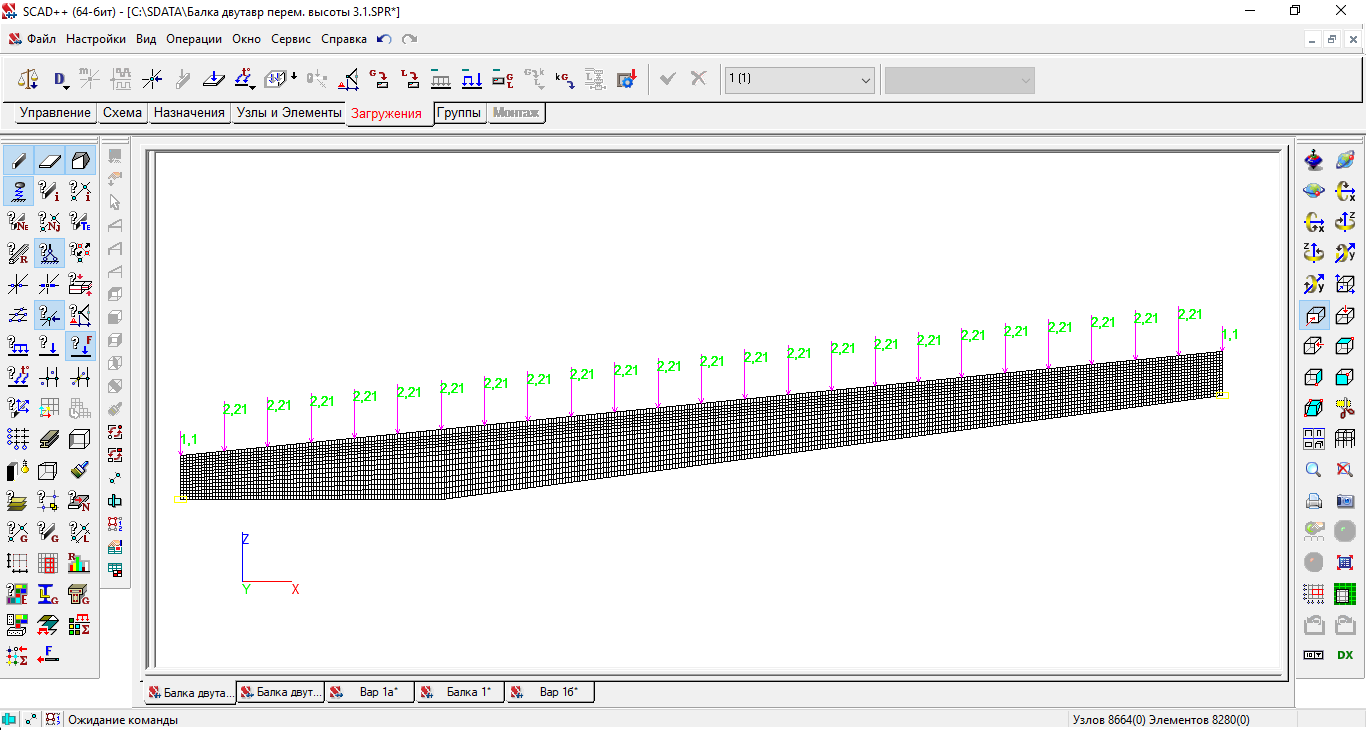
Fig. 5.
Finite-element model of plate girder
Table 1
Cross-sections
of universal trusses with 18-24 m span
|
Truss
element
|
Truss
element cross-section made of
|
|
double
angles
|
roll-welded
square
|
electric-welded
round tubes
|
rolled
round tubes
|
|
upper
chord
|
125х8
|
120×7
|
193.7х5
|
194х5
|
|
lower
chord
|
90х7
|
110х6
|
159х5.5
|
133х6.5
|
|
posts
|
50х3
|
80х5
|
70х4
|
68х3
|
|
diagonal
web elements
|
90х7
|
80х5
|
102х4
|
102х4
|
Table
2
Weight and cost
of constructive variants for roof collar ties
|
No.
|
Collar
tie cross section
|
Weight,
t
|
Cost
per 1 t, UAH
|
Cost,
UAH
|
|
1.
|
Truss
of double angles
|
1.63
|
22 912
|
37 350
|
|
2.
|
Truss
of roll-welded square profile
|
1.33
|
22 150
|
29 460
|
|
3.
|
Truss
of electric-welded
round tubes
|
1.35
|
18 975
|
25 620
|
|
4.
|
Truss
of rolled round tubes
|
1.28
|
28 250
|
36 160
|
|
5.
|
Girder
of rolled I-section
|
3.10
|
19 400
|
60 140
|
|
6.
|
Girder
of fabricated I-section (4 mm)
|
1.58
|
19 670
|
31 080
|
|
7.
|
Girder
of fabricated I-section
(6 mm)
|
2.08
|
19 670
|
40 915
|
From the data in the table it is
clearly seen that the smallest weight for the considered industrial
building roof reconstruction conditions has a collar tie in the form
of the truss of rolled round tubes. A slightly larger weight, but
not much, has a collar tie in the form of trusses of roll-welded
square profile and electric-welded round tubes. The largest weight
has a collar tie of rolled I-section. The welded collar tie of
thin-gage high-strength steel takes an intermediate position.
Taking into account the market
value of each type of cross-section, the lowest cost has the collar
tie in the form of the truss of electric-welded tubes. In the second
place there is the collar tie of roll-welded square profile, the
cost of which is 15% higher. The third is ranked the collar tie in
the form of welded fabricated I-section of thin-gage (4 mm thick)
high-strength steel. Its value is higher by almost 18%. The most
uneconomical is the collar tie made of rolled I-section, the cost of
which is more than 2 times higher than that of the collar tie in the
form of the truss of electric-welded tubes.
Originality and practical
value
The research
presented in the publication allows estimating the possibility and
economic efficiency of usage for various types of cross-sections for
the collar tie of a steel non-insulated roof of the industrial
building. At the same time, the study outlined the case of
reconstruction of the short-span (18-24 m) building, which is quite
common nowadays, with the complete roof replacement.
The results
obtained are valid for the conditions of Dnipro, but according to a
similar methodology the degree of efficiency of reconstruction and
rebuilding of steel roofs of industrial buildings can be determined
in practice for other regions of Ukraine as well.
Also, it
should be noted that the conducted study allow us to outline the
range of the most rational constructive solutions of bearing collar
ties for short-span industrial buildings.
Conclusions
Based on the material outlined
in the publication, the following conclusions can be drawn:
1. For
the
reconstruction
conditions of
a steel
roof of
a short-span
(18-24 m)
industrial
building, the
use of
the truss
of
electric-welded
round tubes
is the
most cost
effective as
a bearing
collar tie.
2. In
the second
place, according
to the
degree of
economic
efficiency,
there is
the use
of the
truss of
roll-welded square
profiles, the
cost of
which is
15% higher than
the previous
variant.
Taking into account the higher technological efficiency of the
implementation of node connections for such trusses, under certain
conditions this type of collar tie can be considered the most
rational.
3. Also
noteworthy is the collar tie in the form of fabricated I-section of
small thickness (4 mm) of high-strength steel, the cost of which is
18% higher than the first constructive variant. Therefore, this
section can also be considered as competing with the main
recommended variant (truss of electric-welded round tubes), taking
into account its high manufacturability.
4. The
least effective
of all
considered
variants is
the collar
tie made of
rolled I-section.
Its weight and value are more than 2 times higher than the main
recommended variant (truss of electric-welded round tubes).
LIST OF REFERENCE LINKS
ГОСТ 10704-91.
Трубы стальные электросварные
прямошовные. Сортамент. – Москва :
Стандартинформ, 2007. – 17 с.
ГОСТ 26020-83.
Двутавры стальные горячекатаные с
параллельными гранями полок. Сортамент.
– Москва : Изд-во стандартов, 1984. – 6 с.
ГОСТ
30245-2003. Профили стальные гнутые замкнутые
сварные квадратные и прямоугольные
для строительных конструкций. Технические
условия. – Москва : Изд-во стандартов,
2003. – 15 с.
ГОСТ 8732-78*.
Трубы стальные бесшовные
горячедеформированные. Сортамент. –
Москва : Изд-во стандартов, 1989. – 10 с.
ДБН
В.1.2-2-2006 (зі змінами). Система надійності
та безпеки в будівництві. Навантаження
і впливи. Норми проектування. – Київ
: Держбуд, 2007. – 70 с.
ДБН
В.2.6-220:2017. Покриття будівель і споруд.
– Київ : Мінрегіон України, 2017. – 53 с.
ДБН
В.2.6-198:2014. Сталеві конструкції. Норми
проектування. – Київ : Мінрегіон
України, 2014. –
205 с.
ДСТУ 2251-93
(ГОСТ 8509-93). Кутики сталеві гарячекатані
рівнополичні. Сортамент. – Київ :
Держстандарт України, 1993. – 16 с.
Банніков,
Д. О. Оцінка практичної збіжності
результатів аналізу пластинчастих
моделей в методі скінчених елементів
/ Д. О. Банніков // Нові технології в
будівництві. – 2017. – № 1. – С. 26–31.
Буга, П. Г.
Гражданские, промышленные и
сельскохозяйственные здания / П. Г.
Буга. – Москва : Книга по требованию,
2013. – 349 с.
SCAD Office.
Версия 21. Вычислительный комплекс
SCAD++ / В. С. Карпиловский, Э. З. Криксунов,
А. А. Маляренко, С. Ю. Фиалко. А. В.
Перельмутер, М. А. Перельмутер. – Москва
: СКАД СОФТ, 2015. – 850 с.
Bofang,
Z. The Finite Element Method: Fundamentals and Applications in
Civil, Hydraulic, Mechanical and Aeronautical Engineering / Zhu
Bofang. – Singapore : John Wiley & Sons Singapore Pte. Ltd.,
2018. – 843 p. doi: 10.1002/9781119107323
Johnson,
R. P. Composite Structures of Steel and Concrete: Beams, Slabs,
Columns and Frames for Buildings / R. P. Johnson. – Hoboken :
John Wiley & Sons, Inc., 2018. – 265 p. doi:
10.1002/9781119401353
Singiresu,
S. R. The Finite Element Method in Engineering / S. R. Singiresu. –
6th ed. – Oxford : Butterworth-Heinemann, 2018. – 782 p. doi:
10.1016/c2016-0-01493-6
Shames,
I. H. Energy and Finite Element Methods in Structural Mechanics /
I. H. Shames, C. L. Dym. – New York : Routledge, 2017. – 776 p.
doi:
10.1201/9780203757567
Н.
Г. КРУГЛІКОВА1*,
Д. О. БАННІКОВ2*
1*
Ф-т «Промислове та цивільне будівництво»,
Дніпровський національний університет
залізничного транспорту імені академіка
В. Лазаряна, вул. Лазаряна, 2, Дніпро,
Україна,
49010, тел. +38 (063) 94 67 288, ел. пошта
dnuzt@diit.edu.ua ,
ORCID 0000-0003-2822-6696
2*Каф.
«Будівельне виробництво та геодезія»,
Дніпровський національний університет
залізничного транспорту імені академіка
В. Лазаряна, вул. Лазаряна, 2, Дніпро,
Україна,
49010, тел. +38 (063) 400 43 07, ел. пошта
bdo2020@yahoo.com, ORCID
0000-0002-9019-9679
РАЦІОНАЛЬНА
КОНСТРУКЦІЯ ПОКРИТТЯ
МАЛОПРОГОНОВОЇ
ПРОМИСЛОВОЇ БУДІВЛІ
ДЛЯ УМОВ РЕКОНСТРУКЦІЇ
Мета.
Останнім часом в Україні зростає
попит на повторне використання
промислових будівель, які протягом
певного часу не перебували в експлуатації.
При цьому досить часто конструкція їх
покрівлі потребує повної заміни й
оновлення із сучасних покрівельних
матеріалів з урахуванням вимог нових
державних норм. Тому вибір та обґрунтування
раціональної конструкції сталевого
покриття на прикладі малопрогонової
промислової будівлі (прогін 18–24 м) для
повернення її до експлуатації після
простою є основною метою цієї публікації.
Об’єкт аналізу – неопалювана будівля,
обладнана мостовими кранами незначної
вантажопідйомності (до 10 т). Методика.
Для досягнення поставленої мети виконано
зіставлення конструктивних варіантів
несного сталевого ригеля покрівлі.
Розглянуто два типи перерізу ригеля:
наскрізний – у вигляді ферми й суцільний
– у вигляді двотаврової балки. Перший
тип проаналізовано для чотирьох можливих
типів перерізу елементів – подвійні
кутики, гнутозварний квадратний профіль,
електрозварна кругла труба й прокатна
кругла труба. Другий тип досліджено
для двох можливих типів перерізу –
прокатний двотавровий профіль зі сталі
звичайної міцності і зварний профіль
із тонкостінної сталі підвищеної
міцності. Зіставлення конструктивних
варіантів виконано на основі чисельного
аналізу їх роботи методом скінченних
елементів на базі проектно-обчислювального
комплексу SCAD for Windows. Результати.
Проведене дослідження дає змогу
констатувати, що для умов м. Дніпро
найбільш економічно ефективним варіантом
перерізу сталевого ригеля промислової
будівлі невеликих прогонів є ферма з
електрозварних круглих труб. Також
досить ефективною слід вважати
конструкцію ригеля, виконану з ферм із
гнутозварними квадратними профілями
або зварного двотаврового типу з
тонкостінної сталі підвищеної міцності.
Наукова новизна. Описане в публікації
дослідження дозволяє оцінити можливість,
а також економічну ефективність
використання різних типів перерізів
для ригелів сталевої неутепленої
покрівлі промислової будівлі з метою
реконструкції в м. Дніпро. Практична
значимість. Виконано практичну оцінку
масових і кошторисних показників для
сталевих ригелів різних типів, а також
обґрунтовано методику проведення
подібної оцінки.
Ключові
слова: промислова будівля; ригель;
балка; ферма; проектно-обчислювальний
комплекс SCAD for Windows; метод скінченних
елементів
Н. Г.
КРУГЛИКОВА1*, Д. О. БАННИКОВ2*
1*
Ф-т «Промышленное и гражданское
строительство», Днипровский национальный
университет
железнодорожного транспорта
имени академика В. Лазаряна, ул. Лазаряна,
2, Днипро, Украина,
49010, тел. +38 (063) 94 67 288,
эл. почта dnuzt@diit.edu.ua,
ORCID 0000-0003-2822-6696
2*Каф.
«Строительное производство и геодезия»,
Днипровский национальный университет
железнодорожного транспорта имени
академика В. Лазаряна, ул. Лазаряна, 2,
Днипро,
Украина, 49010, тел. +38 (063) 400 43 07,
эл. почта bdo2020@yahoo.com,
ORCID 0000-0002-9019-9679
РАЦИОНАЛЬНАЯ
КОНСТРУКЦИЯ ПОКРЫТИЯ
МАЛОПРОЛЕТНОГО
ПРОМЫШЛЕННОГО ЗДАНИЯ
ДЛЯ УСЛОВИЙ
РЕКОНСТРУКЦИИ
Цель.
В последнее время в Украине возрастает
спрос на повторное использование
промышленных зданий, которые на
протяжении определенного времени не
находились в эксплуатации. При этом
довольно часто конструкция их покрытия
требует полной замены и обновления из
современных кровельных материалов с
учетом требований новых государственных
норм. Поэтому выбор и обоснование
рациональной конструкции стального
покрытия на примере малопролетного
промышленного здания (пролет 18–24 м)
для возврата в эксплуатацию после
простоя является основной целью
публикации. Объект анализа – неотапливаемое
здание, оборудованное мостовыми кранами
незначительной грузоподъемности (до
10 т). Методика.
Для достижения поставленной цели было
выполнено сопоставление конструктивных
вариантов несущего стального ригеля
покрытия. В качестве таких вариантов
рассмотрено два типа сечения ригеля –
сквозной в виде фермы и сплошной в виде
двутавровой балки. Первый тип
проанализирован для четырех возможных
типов сечения элементов – двойные
уголки, гнутосварной квадратный профиль,
электросварная круглая труба и прокатная
круглая труба. Второй тип исследован
для двух возможных типов сечения –
прокатный двутавровый профиль из стали
обычной прочности и сварной профиль
из тонкостенной стали повышенной
прочности. Сопоставление конструктивных
вариантов выполнено на основе численного
анализа их работы методом конечных
элементов на базе проектно-вычислительного
комплекса SCAD for Windows. Результаты.
Проведенное исследование даёт возможность
констатировать, что для условий г.
Днипро наиболее
экономически эффективным вариантом
сечения стального ригеля промышленного
здания небольших пролетов является
ферма из электросварных круглых труб.
Также достаточно эффективной следует
считать конструкцию ригеля, выполненную
из ферм с гнутосварными квадратными
профилями или сварного двутаврового
типа из тонкостенной стали повышенной
прочности. Научная
новизна. Представленные
в публикации исследования позволяют
оценить возможность и экономическую
эффективность использования различных
типов сечений в качестве ригеля
стального неутепленного покрытия
промышленного здания для условий
реконструкции в г.
Днипро. Практическая
значимость. Выполнена
практическая оценка массовых и
стоимостных показателей для стальных
ригелей различных типов, а также
обоснована методика проведения подобной
оценки.
Ключевые
слова: промышленное здание; ригель;
балка; ферма; проектно-вычислительный
комплекс SCAD for Windows; метод конечных
элементов
REFERENCES
Electrically
welded steel line-weld tubes. Range,
17 GOST
10704-91 (2007). (in Russian)
Hot-rolled steel
I-beam with parallel flange edges. Dimensions, 6
GOST 26020-83
(1984). (in Russian)
Steel
bent closed welded square and rectangular section for building.
Specifications, 15 GOST
30245-2003 (2003). (in Russian)
Truby
stalnye besshovnye goryachedeformirovannye. Sortament,
10 GOST 8732-78*
(1989). (in Russian)
Systema
nadiinosti ta bezpeky v budivnytstvi. Navantazhennia i vplyvy.
Normy proektuvannia, 70
DBN
В.1.2-2:2006
(2007).
(in Ukrainian)
Pokryttia
budivel i sporud, 53
DBN B.2.6-220:2017 (2017). (in
Ukrainian)
Stalevi
konstruktsii. Normy proektuvannia, 205
DBN В.2.6-198:2014
(2014). (in
Ukrainian)
Kutyky
stalevi hariachekatani rivnopolychni. Sortament,
16 DSTU 2251-93
(GОSТ
8509-93) (1993).
(in
Ukrainian)
Bannikov,
D. O. (2017). Otsinka praktychnoi zbizhnosti rezultativ analizu
plastynchastykh modelei v metodi skinchenykh elementiv. Novi
tekhnolohii v budivnytstvi, 1, 26-31.
(in Ukranian)
Buga,
P. G.
(2013). Grazhdanskie,
promyshlennye
i
selskokhozyaystvennye
zdaniya.
Moscow:
Kniga po trebovaniyu.
(in Russian)
Karpilovskiy,
V. S.,
Kriksunov, E.
Z., Malyarenko,
A. A.,
Fialko, S.
Y., Perelmuter,
A. V.,
& Perelmuter,
M. A.
(2015). SCAD Office. Version 21.
Software complex SCAD++. Moscow:
SCAD Soft. (in Russian)
Bofang,
Z. (2018). The Finite Element Method:
Fundamentals and Applications in Civil, Hydraulic, Mechanical and
Aeronautical Engineering.
Singapore: John
Wiley & Sons Singapore Pte.
Ltd. doi: 10.1002/9781119107323 (in
English)
Johnson,
R. P. (2018). Composite Structures of
Steel and Concrete: Beams, Slabs, Columns and Frames for Buildings.
Hoboken: John
Wiley & Sons, Inc. doi:
10.1002/9781119401353
(in English)
Singiresu,
S. R. (2018). The Finite Element
Method in Engineering (6th ed.).
Oxford: Butterworth-Heinemann.
doi: 10.1016/c2016-0-01493-6
(in English)
Shames,
I. H., & Dym, C. L. (2017). Energy
and Finite Element Methods in Structural Mechanics.
New York: Routledge.
doi: 10.1201/9780203757567 (in
English)
Received:
Nov. 16,
2018
Accepted:
March 19, 2019